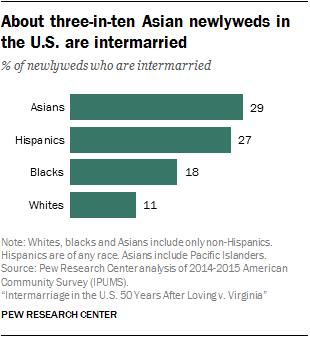Key facts about race and marriage, 50 years after Loving v. Virginia
Richard and Mildred #Loving paved the way for generations of American families. pic.twitter.com/WjDGTezPOX— SPLC (@splcenter) June 12, 2017
 In 1967, the U.S. Supreme Court ruled in the Loving v. Virginia case that marriage across racial lines was legal throughout the country. Intermarriage has increased steadily since then: One-in-six U.S. newlyweds (17%) were married to a person of a different race or ethnicity in 2015, a more than fivefold increase from 3% in 1967. Among all married people in 2015 (not just those who recently wed), 10% are now intermarried – 11 million in total.
In 1967, the U.S. Supreme Court ruled in the Loving v. Virginia case that marriage across racial lines was legal throughout the country. Intermarriage has increased steadily since then: One-in-six U.S. newlyweds (17%) were married to a person of a different race or ethnicity in 2015, a more than fivefold increase from 3% in 1967. Among all married people in 2015 (not just those who recently wed), 10% are now intermarried – 11 million in total.Here are more key findings from Pew Research Center about interracial and interethnic marriage and families on the 50th anniversary of the landmark Supreme Court decision.
1 A growing share of adults say interracial marriage is generally a good thing for American society. Nearly four-in-ten adults (39%) say the growing number of people marrying someone of a different race is good for society, up from 24% in 2010. Adults younger than 30, those with at least a bachelor’s degree and those who identify as a Democrat or lean Democratic are especially likely to say this.
A growing share of adults say interracial marriage is generally a good thing for American society. Nearly four-in-ten adults (39%) say the growing number of people marrying someone of a different race is good for society, up from 24% in 2010. Adults younger than 30, those with at least a bachelor’s degree and those who identify as a Democrat or lean Democratic are especially likely to say this.
 A growing share of adults say interracial marriage is generally a good thing for American society. Nearly four-in-ten adults (39%) say the growing number of people marrying someone of a different race is good for society, up from 24% in 2010. Adults younger than 30, those with at least a bachelor’s degree and those who identify as a Democrat or lean Democratic are especially likely to say this.
A growing share of adults say interracial marriage is generally a good thing for American society. Nearly four-in-ten adults (39%) say the growing number of people marrying someone of a different race is good for society, up from 24% in 2010. Adults younger than 30, those with at least a bachelor’s degree and those who identify as a Democrat or lean Democratic are especially likely to say this.Americans today also are less likely to oppose a close relative marrying someone of a different race or ethnicity. Now, 10% say they would oppose such a marriage in their family, down from 31% in 2000. The biggest decline has occurred among nonblacks: Today, 14% of nonblacks say they would oppose a close relative marrying a black person, down from 63% in 1990.
2 Asian and Hispanic newlyweds are the most likely to be intermarried. Nearly three-in-ten Asian newlyweds (29%) were married to someone of a different race or ethnicity in 2015, as were 27% of Hispanic newlyweds. Intermarriage for these groups was especially prevalent among the U.S. born: 39% of U.S.-born Hispanics and almost half (46%) of U.S.-born Asian newlyweds were intermarried in 2015.
Asian and Hispanic newlyweds are the most likely to be intermarried. Nearly three-in-ten Asian newlyweds (29%) were married to someone of a different race or ethnicity in 2015, as were 27% of Hispanic newlyweds. Intermarriage for these groups was especially prevalent among the U.S. born: 39% of U.S.-born Hispanics and almost half (46%) of U.S.-born Asian newlyweds were intermarried in 2015.
 Asian and Hispanic newlyweds are the most likely to be intermarried. Nearly three-in-ten Asian newlyweds (29%) were married to someone of a different race or ethnicity in 2015, as were 27% of Hispanic newlyweds. Intermarriage for these groups was especially prevalent among the U.S. born: 39% of U.S.-born Hispanics and almost half (46%) of U.S.-born Asian newlyweds were intermarried in 2015.
Asian and Hispanic newlyweds are the most likely to be intermarried. Nearly three-in-ten Asian newlyweds (29%) were married to someone of a different race or ethnicity in 2015, as were 27% of Hispanic newlyweds. Intermarriage for these groups was especially prevalent among the U.S. born: 39% of U.S.-born Hispanics and almost half (46%) of U.S.-born Asian newlyweds were intermarried in 2015.Although Asian and Hispanic newlyweds are most likely to be intermarried, overall increases in intermarriage have been driven in part by rising intermarriage rates among black and white newlyweds. The most dramatic increase has occurred among black newlyweds, whose intermarriage rate more Key facts about race and marriage in the U.S. | Pew Research Center:
